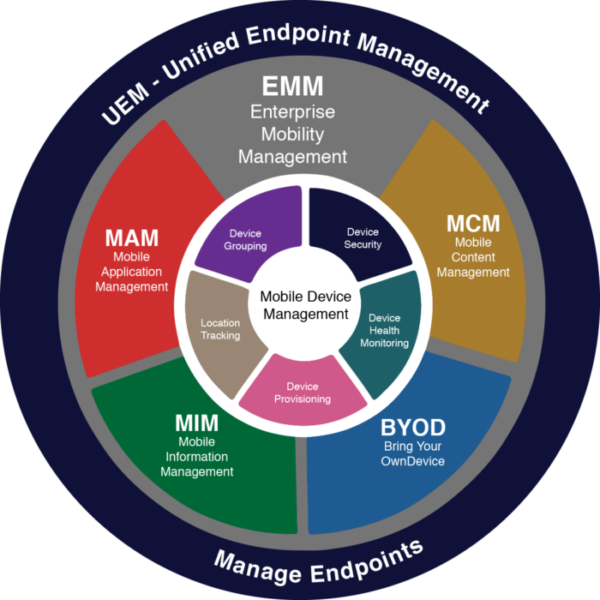Unified Endpoint Management
Valcari is a Unified Endpoint Management (UEM) solution provider founded by mobility experts who have advanced and grown with the Information Technology Mobility evolution. The Valcari experts know mobility because they understand what it takes to run an enterprise environment. From designing the proper infrastructure to meet operational and functional requirements to implementing and integrating systems and services that help businesses support operations and business processes, the Valcari team can securely create comprehensive solutions to meet your business requirements.
Mobility is not a single application added to an organization’s enterprise. Instead, it is a system that requires full lifecycle management to integrate and align with a successful business strategy.

History of UEM-MDM
In the early years of mobility, when organizations and corporations started to get away from the BlackBerry systems (servers and clients), a concept called Mobile Device Management (MDM) was introduced.
MDM focused on the process of developing and implementing systems and strategies to protect the mobile device or the hardware itself, primarily focused on devices such as PDAs, smartphones and/or tablets.
Later, the concept of Mobile Application or Apps Management (MAM) was introduced to meet the requirement on managing the mobile applications or apps that users interacted with to use or access enterprise data on those mobile devices. With this process of allowing mobile apps to interact with enterprise or corporate data, the concept of Mobile Information Management (MIM) or Mobile Content Management (MCM) was introduced. This last concept was the implementing processes, systems, and strategies to apply policies or rules on how enterprise data or content was being manipulated and protected on mobile devices via those mobile apps. All these different concepts expanded MDM functionality, forcing the IT support team to adopt a new concept called Enterprise Mobility Management (EMM). EMM provided a certain solution level by dividing the enterprise and personal data on a device by introducing containers. The containerization of data worked for some time, but it was not a permanent solution.
Many companies developed different mobility management tools, first for MDM and later for MAM, MIM and/or MCM. Some complemented each other, while others interfered with each other’s purposes. For many years during the early phase of the mobility evolution and until today, consumers or the end-users have driven and guided the development of needs and requirements on how corporations or organizations have to modify their IT enterprise systems to support these new types of mobile systems. As a result, many organizations’ IT departments, CIOs, CTOs, and other decision-makers continue to “react” to the security vulnerabilities and threats these mobile systems introduce into their IT environments. This process is not very cost-effective for organizations; it turns IT departments into the most unpopular departments in these organizations and makes them seem like they are not prepared to support the modern world of IT and mobile systems.
The concept encapsulates all the things mobile mentioned before and the addition of managing multiple platforms and operating systems, different devices to include IoT, and the ability to provide a more comprehensive solution to mobility management.
These solutions provided:
• Compliance verification and validation;
• VPNs, gateways, or reverse-proxy secure tunnels;
• Device and app lifecycle – Accomplished by integration with manufacturers and vendor enrollment programs.
Most importantly, all these services are under one umbrella or from a single management console.
Valcari has seen the evolution of IT due to the growth of all things mobility. Plus, with the most recent and aggressive adoption of cloud-based services, the need for a Unified Endpoint Management solution that will solve your IT and security problems today and get your organization ready for the future by modernizing your workforce is important and not a difficult choice to make.